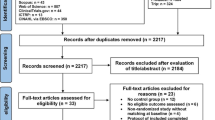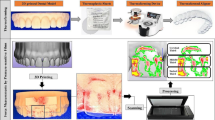Abstract
A recently developed orthodontic wire alloy known as GUMMETAL® is claimed to deliver more physiological forces to correct dental mispositioning. However, its mechanical characteristics have not been fully characterized yet. This study aimed to determine and compare the elastic properties of different wire alloys, such as nickel–titanium (NiTi), stainless steel (SS), and GUMMETAL®, and assess their unloading forces when combined with either conventional or self-ligating brackets (CL and SL) when correcting dental crowding. All wires had a 0.016″ cross-section diameter. A three-point bending test was performed to assess the maximum deflection of each wire. Then, a subsequent analysis measured the unloading force for each wire/bracket system in a dental crowding clinical simulation device. The test was carried out in a universal testing machine with a cross-speed displacement of 0.5 mm/min. Data were recorded in different ranges and statistically evaluated using two-way analysis of variance. GUMMETAL® displayed higher unloading mean forces in SL brackets (2228.78 cN) than CL brackets (1967.38 cN) for the 1.6–3.0 deflection interval (p = 0.018). Within this interval, NiTi showed higher forces when used with CL brackets (2683.06 cN) than with SL brackets (1179.66 cN) (p < 0.0001). For the CL bracket systems, SS wires showed higher forces (2125.31 cN) in the 1.0–1.6 deflection interval than the other two wire alloys (NiTi, 1541.52 cN and GUMMETAL®, 852.65 cN) (p < 0.0001). SS wires also displayed lower forces with SL brackets (1844.01 cN) than in CL brackets (2125.31 cN) (p = 0.049). Thus, only GUMMETAL® revealed to be an optimal choice for SL brackets, whereas NiTi for CL brackets.






Similar content being viewed by others
References
Zheng M, Liu R, Ni Z, Yu Z. Orthod Craniofac Res. 2017;20:127. https://doi.org/10.1111/ocr.12177.
Papageorgiou SN, Koletsi D, Iliadi A, Peltomaki T, Eliades T. Eur J Orthod. 2019. https://doi.org/10.1093/ejo/cjz094.
Nahas-Scocate AC, de Siqueira Brandao A, Patel MP, Lipiec-Ximenez ME, Chilvarquer I, do Valle-Corotti KM. Angle Orthod. 2014;84:279. https://doi.org/10.2319/031213-211.1.
Nanda R. Biomechanics and esthetic strategies in clinical orthodontics. St. Louis: Elsevier Inc.; 2005.
Ren Y, Maltha JC, Kuijpers-Jagtman AM. Angle Orthod. 2003;73:86. https://doi.org/10.1043/0003-3219(2003)0732.0.CO;2.
Schwarz AM. Tissue changes incidental to orthodontic tooth movement. Int J Orthod. 1932;18:331.
Nordstrom B, Shoji T, Anderson WC, Fields HW, Beck MF, Kim DG, et al. Angle Orthod. 2018;88:348. https://doi.org/10.2319/061417-393.1.
Phermsang-Ngarm P, Charoemratrote C. Angle Orthod. 2018;88:425. https://doi.org/10.2319/090317-589.1.
Puttaravuttiporn P, Wongsuwanlert M, Charoemratrote C, Lindauer SJ, Leethanakul C. Angle Orthod. 2018;88:35. https://doi.org/10.2319/071017-456.1.
Ramanathan C, Hofman Z. Eur J Orthod. 2009;31:578. https://doi.org/10.1093/ejo/cjp058.
Chang HP, Tseng YC. Kaohsiung J Med Sci. 2018;34:202. https://doi.org/10.1016/j.kjms.2018.01.010.
Gloriant T, Besse M, Castany P, Cornen M, Gordin DM, Laillé D. How Oxygen Influences the Deformation Mechanism of the “Gum Metal” Titanium Alloy Composition. Mater Sci. 2012;492:706–9.
Hasegawa S. A concept of “en bloc” movement of teeth using gummetal wires. Tokyo: Quintessence Publishing; 2014.
Yanaru K, Yamaguchi K, Kakigawa H, Kozono Y. Dent Mater J. 2003;22:146. https://doi.org/10.4012/dmj.22.146.
Nucera R, Gatto E, Borsellino C, Aceto P, Fabiano F, Matarese G, et al. Angle Orthod. 2014;84:541. https://doi.org/10.2319/060213-416.1.
Alobeid A, Dirk C, Reimann S, El-Bialy T, Jäger A, Bourauel C. J Orofac Orthop. 2017;78:241. https://doi.org/10.1007/s00056-016-0078-5.
Matias M, Freitas MR, Freitas KMS, Janson G, Higa RH, Francisconi MF. J Appl Oral Sci. 2018;26:e20170220. https://doi.org/10.1590/1678-7757-2017-0220.
Nishio C, da Motta AF, Elias CN, Mucha JN. Am J Orthod Dentofacial Orthop. 2004;125:56. https://doi.org/10.1016/j.ajodo.2003.01.005.
Johnson G, Walker MP, Kula K. Angle Orthod. 2005;75:95. https://doi.org/10.1043/0003-3219(2005)0752.0.CO;2.
Hobbelink MG, He Y, Xu J, Xie H, Stoll R, Ye Q. Prog Orthod. 2015;16:37. https://doi.org/10.1186/s40510-015-0109-6.
Kusy RP, Whitley JQ. Semin Orthod. 1997;3:166. https://doi.org/10.1016/s1073-8746(97)80067-9.
Pernier C, Grosgogeat B, Ponsonnet L, Benay G, Lissac M. Eur J Orthod. 2005;27:72. https://doi.org/10.1093/ejo/cjh076.
Koike F, Maruo H, Lacerda-Santo R, Pithon MM, Tanaka OM. Mechanical properties of orthodontic wires on ceramic brackets associated with low friction ligatures. Revis Odontol UNESP. 2017;46:125.
Miura F, Mogi M, Ohura Y, Hamanaka H. Am J Orthod Dentofacial Orthop. 1986;90:1. https://doi.org/10.1016/0889-5406(86)90021-1.
Mertmann M. In: Yahia LH, editior. Shape memory implants. Berlin: Springer-Verlag; 2000.
Kula K, Phillips C, Gibilaro A, Proffit WR. Am J Orthod Dentofacial Orthop. 1998;114:577. https://doi.org/10.1016/s0889-5406(98)70177-5.
Shibasaki WMM, da Silva LH, Fuziy A, Trivino T, Costa ALF, Nahas-Scocate ACR. J Oral Biol Craniofac Res. 2019;9:183. https://doi.org/10.1016/j.jobcr.2018.06.005.
Rinchuse DJ, Miles PG. Am J Orthod Dentofacial Orthop. 2007;132:216. https://doi.org/10.1016/j.ajodo.2006.06.018.
Chen SS, Greenlee GM, Kim JE, Smith CL, Huang GJ. Am J Orthod Dentofacial Orthop. 2010;137:726.e1. https://doi.org/10.1016/j.ajodo.2009.11.009.
do Nascimento LE, de Souza MM, Azevedo AR, Maia LC. Dental Press J Orthod. 2014;19:60. https://doi.org/10.1590/2176-9451.19.1.060-068.oar.
Murakami T, Iijima M, Muguruma T, Yano F, Kawashima I, Mizoguchi I. Dent Mater J. 2015;34:189. https://doi.org/10.4012/dmj.2014-012.
Furuta T, Kuramoto S, Morris JW, Nagasako N, Withey E, Chrzan DC. The mechanism of strength and deformation in Gum Metal. Scr Mercat. 2013;68:e72.
AA El-Bialy T, Dirk C, Jäger A, Keilig L, Bourauel C. J Orofac Orthop. 2019;80:68. https://doi.org/10.1007/s00056-019-00168-8.
Acknowledgements
We appreciate the support of CoraldentⒶ that provided as a gift all GUMMETAL® archwires for this research.
Author information
Authors and Affiliations
Contributions
ACRN-S, MBN, LTS, ACK, DB, and MM collected data. HDPS performed data curation. MCS acquired funds and resources. PMC provided a critical analysis of the data. ACRN-S and EL drafted and revised the paper. All authors approved the final version of this document.
Corresponding author
Ethics declarations
Conflict of interest
The authors declare that they have no conflict of interest.
Additional information
Publisher’s note Springer Nature remains neutral with regard to jurisdictional claims in published maps and institutional affiliations.
Rights and permissions
About this article
Cite this article
Nahás-Scocate, A.C.R., Neves, M.B., de Souza, L.T. et al. An in vitro assessment of the influences of different wire materials and bracket systems when correcting dental crowding. J Mater Sci: Mater Med 31, 108 (2020). https://doi.org/10.1007/s10856-020-06428-z
Received:
Accepted:
Published:
DOI: https://doi.org/10.1007/s10856-020-06428-z




